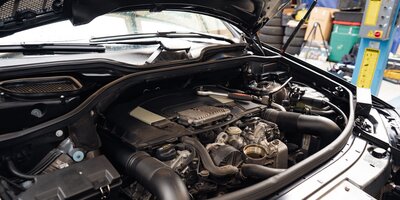BIZOL OIL EXPLAINER: VISCOSITY
What is viscosity?
Put simply, viscosity indicates how thick a fluid is and how easily it flows. The technical definition of viscosity is the measure of a fluid’s internal flow resistance.
How does viscosity affect engine oil selection?
The time it takes for an oil to travel around an engine, especially at low temperatures, depends on the oil’s viscosity. The faster the oil flows around the engine, the better, i.e., the faster it can provide protection and prevent wear. In order to achieve a good flow of oil around the engine and good flow properties at low temperatures, the oil must be low-viscosity.
High viscosity = viscous = slow flowing = more stable film
Low viscosity = fluid = fast flowing = less stable film
In 1975 a common system of grading engine oils according to their viscosity was agreed. A group of renowned standardisation institutes consisting of the International Standards Organization (ISO), American Society for Testing and Materials (ASTM), Society for Tribologists and Lubrication Engineers (STLE), British Standards Institute (BSI) and Deutsches Institute for Normung (DIN) created a common viscosity classification. The resulting system is known as the International Standards Organization Viscosity Grade, ISO VG.
Under the ISO VG system, oils are generally separated into two main groups, multigrade oils and monograde oils. Multigrade oils must fulfil two viscosity specifications, their viscosity grade consists of two numbers such as 5W-30, for example. The 5W part refers to the low-temperature viscosity or how the oil behaves in winter, 30 refers to the high-temperature viscosity (summer). Modern automotive engine oils are almost exclusively multigrade oils.
Viscosity Index
The viscosity index is a crucial metric, which can be used to assess the viscosity stability of an oil.
Many lubricant applications, for example engine oil, require the lubricant to perform near uniformly across a wide range of operating conditions. Automotive lubricants are required to work at cold ambient temperatures i.e., down to -40°C and up to 200°C. Quality oils that have a high viscosity index (VI) remain stable with minimal variation in viscosity over the entire temperature range. Engine manufacturers specify oils that behave consistently to ensure consistent lubrication performance, permitting only minimal wear under normal operating conditions.
The viscosity index describes the change in viscosity with temperature and is calculated from the kinematic viscosity at 40°C and 100°C. As a rule, the higher the viscosity index, the lower the change in viscosity with increasing temperature i.e., the oil viscosity behaves in a more stable manner for longer. Traditionally, synthetic oils were out on their own in terms of viscosity stability, but nowadays a high-quality hydrocracked oil can easily compete with synthetics. Most modern hydrocraked oils have a very high viscosity index, meaning that a fully-synthetic oil no longer has this advantage over HC oils. The aim is to keep the viscosity as stable as possible and keep the line (see fig.1), as flat as possible.

Figure 1 – Viscosity index comparison
Cold Cranking (viscosity) Simulator (CCS)
A cold cranking (viscosity) simulator or CCS, is a device used to determine the low temperature performance of lubricants, when starting a cold engine i.e., during the cold-cranking phase. The procedure simulates the viscosity of oil in crankshaft bearings when starting the engine at low-temperatures. The cold-cranking simulator is a requirement which is used to define the viscosity grade of the oil. CCS viscosity is one of the factors used to define the “W” or “winter” part of a multigrade oil.
HTHS Viscosity
HTHS viscosity is a measure of lubricant flow resistance under dynamic conditions.
HTHS dynamic viscosity is the industry standard that best replicates engine oil behaviour. HTHS dynamic viscosity is designed to ensure engine lubricants maintain sufficient film strength to prevent excessive wear under engine operating conditions, whilst maintaining a viscosity low enough to improve fuel efficiency and emissions. HTHS viscosity is measured at 150°C, to simulate realistic oil shearing conditions in an engine using a tapered bearing simulator viscometer.
Measuring Kinematic Viscosity
Kinematic Viscosity describes the resistance of a liquid to flow under the influence of gravity.
Kinematic viscosity is measured by timing how long it takes oil to pass through the orifice of a capillary when only subjected to the force of gravity; see Figure 2. The orifice of the u-tube viscometer produces a fixed resistance to flow. Different sized capillaries are available to support fluids of varying viscosity.
The time it takes for a fluid to flow through the capillary tube can be converted to a kinematic viscosity using a simple calibration constant provided for each tube.

Figure 2 – Illustration shows a u-tube viscometer
Measuring Dynamic Viscosity TEST
Dynamic viscosity is measured as the resistance to flow when an external and controlled application of force is used to press oil through a capillary tube. Alternatively, a body can be forced through the fluid by application of an external controlled force, such as a spindle driven by a motor. The rotational viscometer measures the torque required to turn an object in a fluid as a function of that fluid’s viscosity as shown in Figure 3.

Figure 3 – Illustration shows a rotational viscometer
And if all of that information does not convince you, watch this Fifth Gear Oil Test video.
Please note we are not responsible for the content on third-party websites. By clicking on the link, you will be directed to a website containing third-party content. We have added this link for your information and have no affiliation with the provider of this content.

You might also like

The modern marvel of an internal combustion motor powers our vehicles, providing the strength and reliability we rely on for daily transportation. However, just like anything else subjected to constant use, motorized units experience wear and tear over time. Component deterioration can significantly impact performance and longevity. In this article, we will delve into the intricacies of engine wear meaning, explore the various causes behind it, provide actionable tips to reduce and prevent it. Furthermore, we will look at how specialized engine oils, such as BIZOL, play a crucial role in safeguarding your engine’s health. Let’s begin by understanding what engine wear is and the factors that contribute to it.

The melodious purr of a motor, the velvety transition of cog-wheel, and the elegant voyage along the expansive highway — these are the unmistakable characteristics of a meticulously calibrated self-shifting gearbox system. But what transpires when the motorized ensemble falters, the cogs gnash, and the voyage veers into an unforeseen tempest? Get into the realm of automatic transmission problems, a domain where automotive aficionados and everyday motorists alike encounter the enigmatic intricacies of this complex system.

Driving is a blend of exhilaration and convenience, but sometimes, your trusty car can hit a snag. One of the most frustrating issues is a coolant leak.
Coolant, often referred to as the versatile 'antifreeze,' assumes the uncelebrated role of an automotive guardian, ensuring your engine's harmonious operation. This unassuming fluid stands as a bulwark against the scorching summer heat and the bone-chilling cold of winter. Nevertheless, when the vigilance of antifreeze wanes, and it embarks on an unauthorized journey beyond its confines, ominous troubles come into view.

